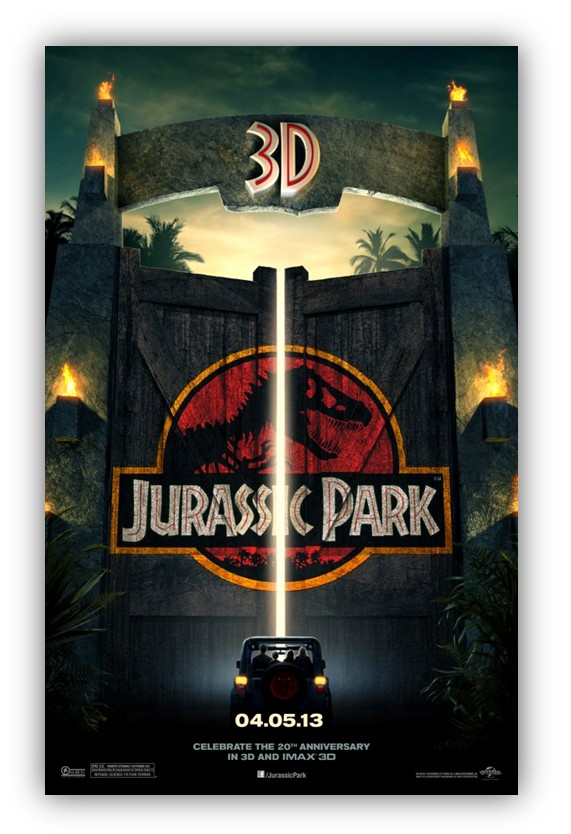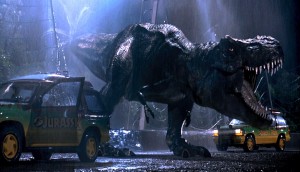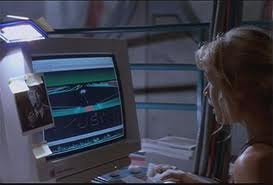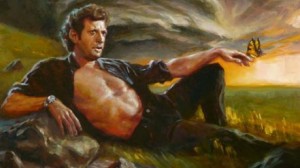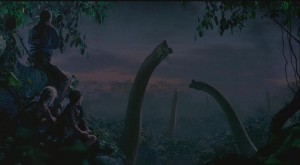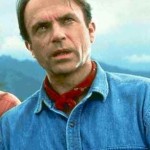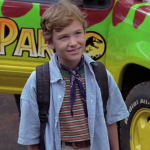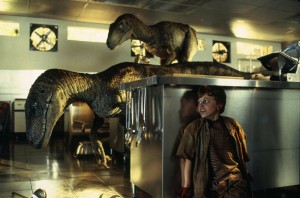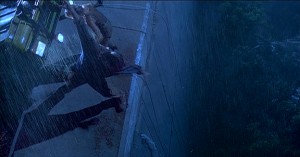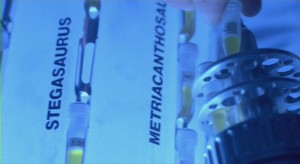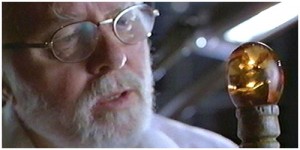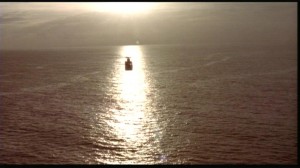While Jurassic Park is not the first movie I ever had the pleasure of viewing in theatres (more on that in a later article), it holds the distinction of being not only the first live action movie I was taken to see, but the movie that utterly transformed me into a full-fledged nerd. When I was but five years old, my mother told me that there would be a movie coming out in the summer that was about a theme park consisting of live dinosaurs. My little brain took off running, and I instantly took out every book I could find regarding dinosaur history, etymology, and paleontological studies, going so far as to give a lecture on dinosaurs both in my kindergarten class and at the Ohio Valley Yearly Meeting (church camp for Quakers). Needless to say, while I remain convinced to this day that I was a natural born lecturer from the age of six (my birthday happened before the movie was released), my classmates were less interested in the distinction between saurischian and ornithischian hip structures and more interested in Power Rangers, TMNT, and Battle Trolls. (That ought to date my coming of age properly.)
(Sidenote #1: This ability has never left me. One of my lab sciences, designed to fill out a liberal arts education centered around the double whammy of majors in Theatre: Acting/Directing and Film Studies, was the Geologic History of the Dinosaurs. A Wednesday tradition that semester was to hold court at the local Panera Bread, where I would orate about the differences between hadrosaur skull structures while my friends and colleagues devoured French onion soup. My main realization of those afternoon seminars is that not much has changed since I was in kindergarten, especially as I realized the most effective way of teaching the differences between dinos was to pretend to be one of the creatures we were studying and attack my friends until they could tell me five facts about what dinosaur I was supposed to be. But I digress.)
Regardless, I instantly loved Jurassic Park. Granted, it gave me nightmares at an age when I probably didn’t need to be seeing lawyers bisected by T-Rex teeth or fat men blinded and eviscerated by hybrids of dinosaurs and spitting cobras, but there was enough sheer wonderment and spectacle within the movie that I was hooked forever on the power of cinema to transport viewers into thoroughly convincing worlds. I saw the movie at least five times, dragging my parents willingly or no along with me in an effort to remain within the world as long as I could. I wore down multiple copies of the Michael Crichton book, reading it at far too early an age to be appropriately healthy, collected every single JP toy, and proceeded to wear out not just my VHS copies of the film, but also our VCR.
In short, I was, and continue to be, awesome because I fell in love with Jurassic Park.
Twenty years later, Universal Studios has rereleased Jurassic Park, spending oodles of money to convert the film to 3D, using “all the latest technologies” to ensure that a new generation can enjoy it as it was meant to be seen, on the big screen, whilst older viewers can trip back into nostalgia mode, recapturing either their childhoods or a time in life when things were good.
Rather than writing a full-fledged review of the film, I have chosen instead to record several distinct observations about the film. I do this because A) 99% of our readership (which might be 99 people, or 999 people, but who can really tell?) have already seen the movie, and B) reviewing a 20 year old movie might seem redundant. Think of this less as a review than as a “study guide” on what to look for when re-watching one of the most technologically important movies of the past twenty-five years.
1) The technology used for the CGI Dinosaurs hold up remarkably well…
At the time Jurassic Park was released, the dinosaur effects used were groundbreaking. That word gets thrown around a great deal in this age of Transformers, Avengers, and Avatars, so let’s be fully honest and forthcoming here: prior to the release of Jurassic Park, there had never been as fully convincing a use of CGI in movies (aside from T2: Judgment Day, but watching that again, let’s get real and admit that liquid Robert Patrick looks like a bad toothpaste commercial). While watching the movie in 3D, the dinosaurs move with a sense of weight that filmmakers have struggled to fully realize ever since its release, and while the practical effects are what they are, they remain fully effective at conveying the majestic presence of the various dinosaurs.
2) …while the practical technology within the movie has aged…less well…
“This computer has a CD-Rom!”
And the audience bursts out with laughter.
To be sure, the gigantic, bulky IBM computers used within the movie have become a sort of dinosaur in their own right. Even the Barbasol shaving cream can would more likely be a can of Gillette shaving gel if the movie were released in present day times. But then again, these were the modern technologies of 1993, so cut Steven Spielberg a break. At least the touchscreen in the Land Cruisers kind of precipitates the coming of the iPhone/iPad generation…kind of.
3) My identification with the characters shifts the older I get.
This is more a personal revelation than a widespread generalization, but I’m sure it holds true in some sense for others of my generation who watched this movie in their childhoods. When I first saw the film, I naturally identified with the kids, who were struck with awe, wonderment, and terror at the dinosaurs of Jurassic Park. The adults I liked were the stock, stereotypical supporting characters populating the background; players such as Wayne Knight and Bob Peck were easier to grasp in my mind than the complex leading characters, though I did laugh at their various antics. Sam Neill’s Alan Grant was my ideal father figure, a role he played (and still plays) to perfection in the movie proper.
Watching this movie with 20 years of life experience, my perspectives have changed, though I didn’t realize it as much until I watched it on a big screen, surrounded by other twenty-somethings who’d grown up with the movie. Now the kids just seemed like nuisances, making more problems for the adults than were warranted. (“We are surrounded by killer dinosaurs, Jeff Goldblum’s leg might literally fall off at any second, and we’re dehydrated, so I think you can climb down the god-damn fence, you little brat!”) The stock characters are just that: plot devices to further the film along. Meanwhile, characters such as Ian Malcolm take on a new perspective. In 1993, I just thought he was a funny, smart scientist with a proper sense of foresight that no one else wanted to listen to. Watching the film again, I was floored to observe how much of the movie Malcolm spends hitting on Laura Dern’s paleobotanist character. Every move he makes for the first third of the movie, even when lecturing on chaos theory, is designed solely to get into Ellie Sattler’s pants (er, shorts). As a child, I didn’t know any better when observing this behavior. Now, I recognize it because I know that guy. I’ve hung out with that guy. Hell, I’ve been that guy.
Like I said, a change in perspective.
4) The 3D conversion is breathtaking, majestic, and completely warranted.
The island of Isla Nublar (or Hawaii for those with less sense of imagination) is amplified greatly by the use of 3D technology. There are depths and valleys that go completely unnoticed by viewing the film in 3D. The opening entrance to the island, from the helicopter descending to the landing pad to the spectacle of the dinosaur herds in the lagoon, gains new depth and transcendent luxury that feeds the overall sense of wonderment that is the film’s message. There are few other movies where the use of technology is mirrored so perfectly by the film’s narrative and characters. What I mean by that is that as a viewer, we were/are awed by the presence of dinosaurs onscreen. Within the world of the film, the characters are awed by the presence of dinosaurs in real life. The combination of those two elements (verisimilitude, for those with a more critical eye, thank you Mr. Ebert) is something that Spielberg has always mastered in cinema, more so than any other director in the history of cinema. Adding 3D to the mix is simply adding another layer to a movie obsessed with the childhood delight of seeing prehistoric beasts come to life.
Granted, there are a few moments where 3D hinders rather than accents the proceedings onscreen. These moments mostly come where an out-of-focus microscope in the foreground is given such depth that to regard it makes the eyes hurt from trying to peer around the fuzzy lab tables. At one moment, during the Gallimimus stampede, the log that Grant and the two children are hiding behind is rendered with such detail in 3D that I found myself trying to actually look around it, as though that would present me with a better vantage point of the T-Rex chewing a Gallimimus into mincement. (For those crying spoilers, I’ll calmly remind you that the Statute of Limitations of Spoilers has run out on Jurassic Park. Get over yourselves.) Sure, this goes to show how well the 3D has been rendered, and with that in mind, mine is a minor gripe.
5) Alex Bean has ruined one of my favorite scenes in all of cinema…
…because he showed me this clip. You bastard.
Watching the movie, I could NOT get it out of my head when the proper time came onscreen. John Williams’ score is perfect for 3D. Less so the melodica.
6) Tim Murphy is dressed exactly like Dr. Grant.
This is much more of a personal observation on my part, but it goes to show how watching a movie on the big screen after years of viewing it on small TVs can reveal small, nuanced details that have somehow escaped my notice for twenty years. Such as how Tim is aping his role model’s dress right down to the handkerchief tied around his neck (boy shorts vs. rugged man pants aside). Other moments I noticed this time around include Ellie crying with joy over the triceratops, Malcolm wincing when Hammond sets the blueprints on his injured leg, and that freaking hole in the wall that the T-Rex enters through to attack the raptors in the Visitor Center.
Oh, on that note…
7) Velociraptors are FREAKING TERRIFYING IN 3D.
We all know the moments designed to make the audience jump. Everyone in the theatre knew they were coming. Yet, in 3D, the velociraptors are even more terrifying than they were in 2D. Jurassic Park as a whole is filled with some of the best action set-pieces in cinema, including the T-Rex attack on the stalled Land Cruisers, the aforementioned stampede, and the raptor hunt in the kitchen. While seeing the movie on the bigscreen reinforced just how animalistic most of the dinosaurs are, particularly the big, dumb, curious T-Rex, the velociraptors here are imbued with a sense of cunning, malice, and downright maliciousness that reminds me of why I had nightmares for years and years after seeing this movie. Thanks, Mr. Spielberg. I really needed that. Thanks a lot.
8) Dr. Grant’s fridge in the trailer in Montana is plastered over with conspiracy theories.
This would go under the heading of #6 on my list, except that it adds several elements that I never really considered about the movie in the first place. While watching the film, I noticed a cut-out newspaper headline about aliens stealing some guy’s face, (I’m paraphrasing because I don’t remember the exact details because Dinosaurs happened.) as well as a fuzzy portrait of what looked to be Bigfoot. These seemed an odd choice of background material to be used as set decoration, particularly when they’re not called upon again throughout the movie. What they do, however, is reinforce a particularly notorious distinction of some scientists. After the movie, my friend Rob commented upon my observation that many scientists (not a majority, but enough to be more than a few) are devout believers of conspiracy theories; keeping this in mind, it makes sense that Alan Grant, a loner eking out his trade in the badlands of Montana, would buy in to conspiracy theories. As a character trait, it need not be made a focal point of his character, yet it makes his sudden transformation from wonder to doubt all the more believable once he realizes that the genetic scientists of Jurassic Park have been breeding raptors willy-nilly, without any thought as to the consequences. If Jurassic Park were remade in the present day, that little trait would become a main feature of Dr. Grant, pushed to the forefront and bludgeoned to death. Here, under Spielberg’s masterful touch, it’s just another delightful element of character development that only makes an appearance for a brief glimpse before moving on to bigger and more important things. Which is awesome.
9) The geography of many of the events of Jurassic Park makes absolutely no sense.
This has been done to death on the Internet, but watch the T-Rex attack in the middle of the film, just to enjoy how thrilling and well-staged each element of the scene has been done. Then watch it again, paying close attention to the landscape and the geography of where they are.
I rest my case.
Now, I’m not saying this detracts from the scene, because ‘holy crap, Steven Spielberg knows what he’s doing’, but in the hands of a less talented director, the sudden appearance of a 100 foot trench would reduce this attack to a mere footnote in a laughable mess. Bravo Mr. Spielberg.
9A) The spelling of Stegosaurus is still horrendously wrong.
A minor grievance, but if they can change Star Wars so that Greedo shoots first, SURELY there’s a computerized equivalent of white-out to fix the atrocious spelling that results in ‘Stegasaurus’ during the embryo theft scene. Guh.
10) John Hammond is more of a tragic figure in this film than I first realized.
As a childlike Walt Disney figure, Hammond was always a delight for me. Richard Attenborough’s performance as the eccentric billionaire founder of the park is utterly charming, with only a thin layer of menace underneath in his dealings with Nedry and, to a slight extent, Malcolm. His character’s transformation from all-controlling megalomaniac to concerned patriarchal leader is elegant, yet imbued with a sense of sadness. All Hammond really wants was to bring true and real delight to people all across the world, yet the only way he knows how to do that is by controlling every element of his production. When that is taken away from him, all that is left for him is a sense of loss of the spectacle that was so briefly within his grasp. I knew that this was his arc ever since I first saw it years ago, but it wasn’t really cemented in my mind until I watched the final scenes of the movie unfold on the big screen. As the survivors are loaded into the rescue helicopter, Hammond steps back out at the call of the brachiosaurs, his eyes peering towards the park in an attempt to view the majesty of his creation one last time. Now, in prior viewings, I always felt that he willingly turned his back on the scene at Dr. Grant’s insistence. Rewatching it, I now realize that Dr. Grant has to forcefully drag him away from the park. Even at the end, recognizing that everything has fallen apart and Jurassic Park can never be, Hammond holds to the childlike wonder that, for a brief second, dinosaurs and man could have functioned together in an act of his own creation. Deprived of it, he does not go gently into that good night. This makes the final shots of him staring wistfully at his amber-topped cane all the more tragic to me; these are the laments of a man who has been stripped of all his illusions and dreams. His sense of wonder has been broken, forever reduced to a memory.
And that’s kind of heartbreaking, a reminder of the fleeting spectacle that is life when you really think about it. That’s why, for me, Grant’s rapturous joy at seeing the birds flying across the ocean reassures the audience that even though the dinosaurs of Jurassic Park are not real, there are wonders enough within the real world, and they are there for all of our enjoyment, young and old alike. Life will find a way to keep the magic of the world alive.
And that’s what the power of movies is all about, when you get down to it.
Go see Jurassic Park 3D. You won’t regret it. They’ve spared no expense.

